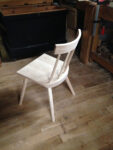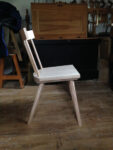When I work on a complex design, such as this simple chair, I find the best way to modify the design is to take photos of the project from all angles, even awkward ones. Then I print them out and start sketching on them.
This process saves me hours of prototyping. In this case, I’m working on the crest rail of the chair, mostly the angle that is cut on the ends and its overall length.
For me, this is easier than modeling complex pieces in CAD. I know it looks primitive, but it works surprisingly well.
— Christopher Schwarz









Fantastic Photography !!!
Sometimes we fuss too much…some of the best works just springs from the bench…to quote James Ayres from the introduction fof my craft website list: “It will help our mature artisans to become more visually literate (i.e. visuate) so that they have such a “deep understanding of the language of their craft that, once mastered, it can be translated into the idiom of the moment.” (James Ayres) It is designed for hands that think” That takes a life time considering the miserable apprentice programmes we have i n the USA..
Richard O. Byrne
I don’t know – my experience has pretty universally been that the best work rarely just springs from the bench. To a one, the most capable and visually literate craftsmen I know all spend an incredible amount of time on refinement. Sketches, revised sketches, revisions of the revisions, followed by mock ups followed by revised sketches and strategies like Chris mentions here (which is actually really common in my experience) – see things are pretty much ubiquitous in the best designers I know.
I like the sentiment behind your statement, but I just haven’t found it to be the case in very many situations other than those where the maker is essentially riffing on a single set of themes and practices recursively (I’m thinking of people like Follansbee and many of the best turners) in which case, the iterative process has just become the background rather than imbued in a single piece.
I don’t want to seem contrarian or anything, but I think sometimes we do people a disservice by hiding the intense hours of process behind the designs. To me, good design is almost entirely about putting in the time and work of repetition and iteration. – inspiration is a fleeting impulse that gets you to pick up the pencil, but not much more.
“inspiration is a fleeting impulse that gets you to pick up the pencil, but not much more.” try picking up a hand plane and some wood too, then maybe the design will spring from the bench?
I’d try the hand plane thing, I guess, but I’d have to learn how to sharpen.
You should show some of the marked up photos.
I have:
https://blog.lostartpress.com/2015/04/22/in-praise-of-napkincad-1-0/
I like that the legs have a harmonious look to them viewed at any angle, well done.
A four-legged chair? How conventional.
What happened to the man who brought us three legged chairs and five (or was it six?) legged tables?
Does the back feel strong enough when you lean back?
Yup. Even unglued.
Nice. I’ve been looking at windsors and wondering if continuous arms with forward angled sticks were needed. Guess not. That really opens up possible designs. Thx
Woodworkers’ equivalent of REPL (read/eval/print/loop). From some reason, it’s hard for me to speak the same language of 3d cad programs, it takes too much time to convey the shape that’s already alive in your head. Viva el napkins.
Viva la… Viva!
Thanks for the tips! I do as much design work as I can on paper at 1/2 scale, and then move to full scale mock ups as soon as I start bogging down on details, using whatever scraps of plywood, mdf, pine or whatever else is lying around. Screw things together and walk around it. I’ll have to try the drawing on photos though. That sounds really helpful.